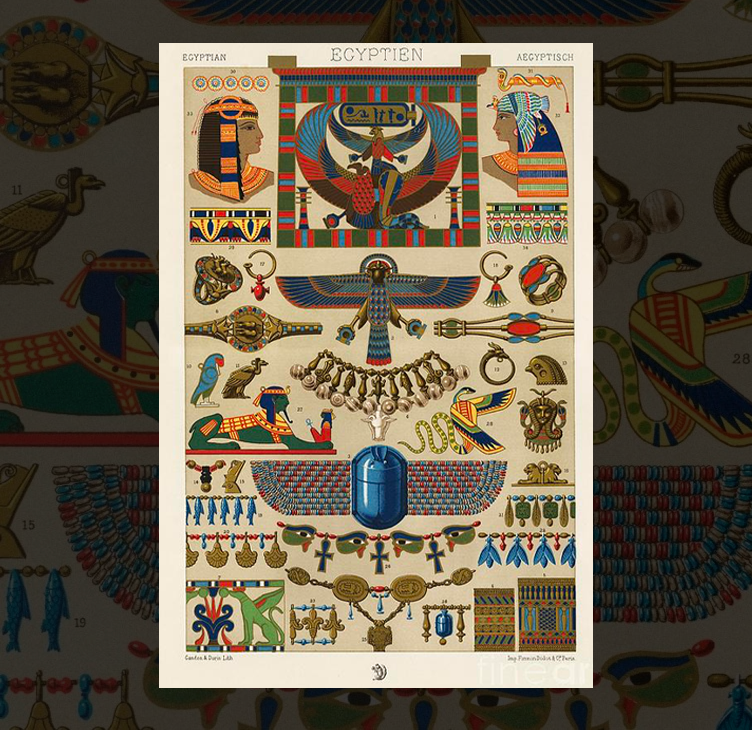Cartier, Egyptian revival jewels
In the early 20th century several events sparked a strong interest in Europe for the Egyptian culture also known as “Egyptomania” : the opening of the Suez Canal in 1869, several major discoveries including the tomb of Tutankhamun in 1922 as well as a Franco-Egyptian exhibition in Le Louvre in 1911. This fascination would quickly bear a strong influence on all fields of the French decorative arts including the jewelry scene until the end of the 1920s.
Howard Carter examining his discovery of King Tut in Egypt in 1922.
© Wikipedia Commons
British Tourist visiting the Pyramids, around 1900.
The most important jewelries houses such as Van Cleef & Arpels, Tiffany, Bvlgari drew their inspiration from the lost civilization by using different common Egyptian patterns and symbols. The stones of different colors and hard stones such as onyx or lapis lazuli were perfectly chosen to create delicate outlines in an overall geometric design idiosyncratic of the Art Deco movement.
Van Cleef & Arpels
An Egyptian-inspired brooch, 1924
Platinum, emeralds, rubies, rock crystal, onyx, diamonds
© Van Cleef & Arpels
Bvlgari
A brooch Designed as an Egyptian papyrus flower
Coral, chalcedony and diamond
© Christie’s
However what would separate Cartier from its competitors was the attention given to details and the historical accuracy when creating “Egyptian pieces”, revealing a deep interest and real willingness to study the history of this lost civilization.
Indeed, Louis Cartier, a young ambitious and curious young man, always on the look for new sources of inspiration quickly became an avid collector of Egyptian objects and deeply studied its culture through books, painting, engraving etc…
Egyptian pattern from L'ornement Polychrome (1888) by Albert Racinet (1825-1893).
Among the main sources of inspiration, not only for Cartier but for the whole Egyptomania movement, in Europe was the Grammar of Ornaments by Owen Jones published in 1856, illustrating in a very detailed and colorful manner the various ornaments of Egypt.
Under the impulsion of Louis, Cartier started creating pieces not only inspired from Egyptian symbols but also directly made out of real Egyptian objects acquired in the collection of the most prominent antique dealers of that time. These Egyptian objects dating from 1500 to 3000 years were given a second life by being transformed into jewels.
Cartier, circa 1925
A Rare and Important 18 Karat Gold, Platinum, Faience, Diamond, Colored Stone and Enamel 'Sekhmet' Brooch
© Sotheby’s
Cartier, circa 1923
A Magnificent and Rare Egyptian-Revival Faience and Jeweled Brooch
© Sotheby’s
Cartier, circa 1923
A Platinum, Gold, Diamond, Faience and Colored Stone 'Pylon' Brooch
© Sotheby’s
Cartier, 1923
An Egyptian-Revival Jeweled Fan Brooch
© Sotheby’
Among the most original creations of Cartier is a brooch (that could also be worn as a belt buckle) representing a winged scarab carved in quartz with emerald eyes, egyptian blue faience wings and diamonds.
Cartier
A sketch of the scarab belt buckle brooch
© Courtesy of Cartier
Cartier
An Egyptian-Style Jeweled Scarab Belt Buckle, 1926
© Sotheby’s
Cartier, 1924.
Scarab brooch (or belt buckle)
Gold, platinum, Egyptian blue earthenware, quartz (scarab), diamonds, emerald, enamel.
© Cartier
These unique pieces mixing diamonds, precious metals, faience and colored stone were mainly produced by Cartier for its own archive and very few were sold to final clients which explains why they have become so rare and coveted nowadays.
Cartier, 1925
An Egyptian Sarcophagus Vanity Case
Gold, platinum, engraved bone, diamonds, emeralds, sapphires, onyx, enamel
The engraved bone plate representing a standing female figure comes from ancient apprêts
© Cartier
Therefore, when a piece happens to be for sale on the market, it quickly lures many avid collectors ready to spend a significant amount of money to acquire a real and unique piece of history, such as this art deco multi gem and diamond egyptian revival brooch which appeared at Christie’s in 2021 with an initial estimate of 60,000-80,000$ and that eventually sold for over 250,000$.
Cartier
An Art Deco Multi-Gem and Diamond Egyptian Revival Brooch
Circa 1924, signed Cartier, Londres
© Christie’s
Even if the Egyptomonia in Europe quickly vanished after the 1930s, Cartier never totally forgot the influence of this movement and overtime kept creating pieces referring to the lost civilization such as this beautiful gold and steel “Tanis” watch designed as cuff bracelet, the case depicting a scarab from the 1990s which recently appeared at auction at Sotheby’s.
Cartier
A Gold and steel lady's wristwatch, 'Tanis'
Circa 1990
© Sotheby’s
















